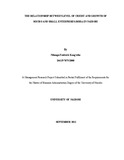| dc.description.abstract | SMEs are generally undercapitalised, suggesting major operational difficulties in
accessing credit and pursuing corporate goals. The Baseline Survey (2000) showed that
only six percent of SMEs successfully applied for and used credit. It is unclear how the
rest who form the majority, meet their working capital and investment needs. Enterprises
that successfully sought out credit received very modest amounts, probably reflecting the
level of activities in which the enterprises are involved (Kimuyu & Omiti, 2000).The
extent to which entrepreneurs in Kenya can actually benefit from the utilization of this
potential and the factors that influence the adoption of this potential has been unclear. As
such, the main purpose of this study was to assess the relationship of credit on growth of
micro and small enterprises (MSEs) in Nairobi.
Both qualitative and quantitative methods were used for data analysis. Quantitative
methods of data analysis such as use of percentages and frequencies were employed in
this research. Information was presented in the form of tables and Pie Charts. Growth to
be analyzed for the purpose of this study was limited to a period of time that is from 1990
to date. The analysis focused on the changes in following variables: - assets in an
enterprise, turnover, investments, outlets and branches. These variables were used to
establish generalizations or facts in achieving the objective of the study, which was to
determine the impact of credit financing on the growth of the SMEs sector in Kenya.
From the study findings most of the businesses were getting credit from financial
institutions as banks have been presented as a reliable source of finance for most
businesses. Further the study found micro finance institutions to have been readily
available and to have high level of credit. From the study findings most of the businesses
were being financed by micro finance institutions as compared to other commercial
banks.
The study in its recommendations noted the need for borrowers to be educated on credit
usage and how to make repayments so as to maintain their creditworthiness. The micro
finance should adopt a reducing balance mode of repayment in order to attract more
borrowers. For the vision 2030 to become a reality and poverty eradication to achieve its
goals, credit has to be made available to finance the required areas of investment | en_US |



